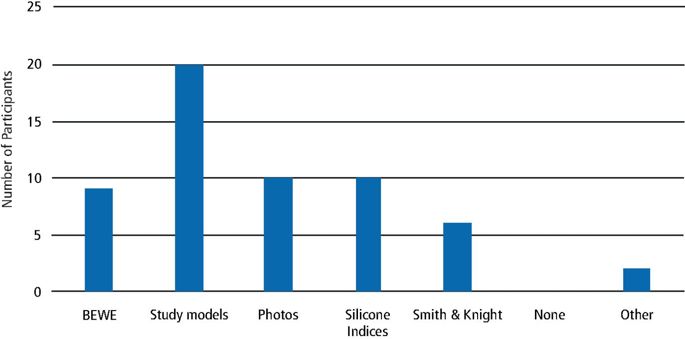British Dental Journal ( IF 2.6 ) Pub Date : 2020-03-27 , DOI: 10.1038/s41415-020-1314-3 Mark O'Hara 1 , Brian J Millar 2

|
Aim To evaluate currently available methods for assessing and monitoring tooth wear in a general dental practice environment.
Method A questionnaire was developed and used to obtain data. Models were used to test the dentists' assessment of tooth wear. Ethical permission was obtained.
Results Twenty general dental practitioners were interviewed and 100% were aware of the use of study models, 50% about the use of photographs and 45% of the BEWE. Methods used to assess and monitor tooth wear were study models (75%), photographs (65%), BEWE (10%), Smith & Knight index (0%) and no method (15%). Sixty-five percent of dentists were unaware of any guidelines on monitoring tooth wear. In comparing serial photographs, no participant correctly identified all the wear changes and 25% thought a change had occurred when one hadn't. Statistical analysis showed a sensitivity of only 73% with a specificity of 75%. In comparing serial study models (same cases as used in the photographs), 55% of participants identified a change when no change occurred and 50-60% of participants were able to correctly identify if wear had or had not occurred. Participants graded the models according to BEWE. Statistical analysis of these results shows a sensitivity of just 69% with a specificity of only 55%. The inter-operator agreement (Fliess' Kappa) showed an even lower degree of agreement was found with only 0.12, which suggests only a slight level of agreement, less than that with photographs.
Conclusion Dentists do not seem to be aware of the current guidelines but do make reasonable attempts to monitor tooth wear. None of the currently available methods are ideal and even the use of serial study models is open to much inter-operator variability.
中文翻译:

普通牙科医生对牙齿磨损评估的评估。
目的评估在常规牙科实践环境中评估和监测牙齿磨损的当前可用方法。
方法编制问卷并用于获取数据。模型被用来测试牙医对牙齿磨损的评估。已获得道德许可。
结果 采访了20位普通牙科医生,其中100%知道使用研究模型,50%知道使用照片和45%的BEWE。用于评估和监测牙齿磨损的方法是研究模型(75%),照片(65%),BEWE(10%),Smith&Knight指数(0%)和无方法(15%)。65%的牙医不知道任何有关监测牙齿磨损的准则。在比较系列照片时,没有参与者正确地识别出所有磨损变化,而有25%的参与者认为没有磨损就发生了变化。统计分析表明,敏感性仅为73%,特异性为75%。在比较系列研究模型(与照片中使用的情况相同)时,55%的参与者在没有发生变化的情况下发现了变化,而50-60%的参与者能够正确地识别是否发生了磨损。参与者根据BEWE对模型进行了评分。这些结果的统计分析表明,灵敏度仅为69%,特异性仅为55%。运营商之间的协议(Fliess'Kappa)显示,甚至只有0.12的协议程度更低,这表明协议的级别很小,低于照片。
结论牙医似乎并不了解当前的指南,但确实做了合理的尝试来监测牙齿的磨损。当前没有可用的方法是理想的,甚至连环研究模型的使用对操作员之间的差异也很大。



























 京公网安备 11010802027423号
京公网安备 11010802027423号